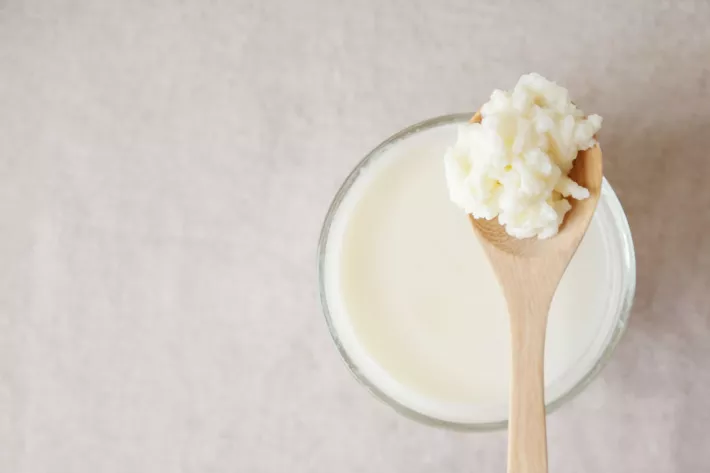We hear a lot about the microbiome these days—the trillions of probiotic bacteria that live on and in us. As we are learning, these microbes contribute to our health in myriad and previously unimagined ways. The beneficial bacteria in your intestines, for example, aid digestion, manufacture nutrients, protect against food-borne pathogens, and even appear to play a role in regulating your body weight.
These helpful creatures can be wiped out by antibiotics and other drug therapies, colonics, or even a bad case of diarrhea. When this happens, you want to restore those beneficial intestinal flora as quickly as possible.
In a couple of weeks, I am scheduled for a routine screening colonoscopy. The preparation for this procedure involves a 24-hour liquid fast, and the administration of a strong laxative designed to flush everything out of my colon, so the doctor can have a look around. Unfortunately, this will probably also decimate my gut bacteria—presenting both a challenge, as well as an opportunity.
The foods that I do (and don’t) eat in the first few days following my procedure will have a big impact on how quickly and well my intestinal bacteria recover. Here are the three things I plan to eat, and the three things I’ll try to avoid:
Foods That Help Replenish Gut Bacteria
- Fermented and Cultured Foods. Kefir, yogurt, miso, kim-chi, natto, sauerkraut and other naturally pickled vegetables each contain different types of probiotic bacteria. We’re just getting started with the huge job of cataloging all the different bacteria in the human gut and figuring out what they do, so it’s way too soon to declare certain probiotic foods (or bacteria) as better than others. In fact, it looks like the diversity of your gut bacteria may matter more than any one individual strain. To that end, I’m going to try to eat as many different fermented and cultured foods as possible as part of my restocking program.
- Prebiotic Foods. I also want to give my new guests plenty of nourishment, to make them feel at home and inclined to stick around. That means serving up plenty of fiber-rich foods. In particular, I want to seek out foods that are high in soluble fiber, such as flax and chia seeds, beans and legumes, apples, oats and oat bran.
- Raw Veggies. Fresh fruit and veggies are also good sources of fiber. And when you eat them raw, you’re more likely to get some of the microbes that live in the soil where they are grown. I talked about soil-based organisms in a previous episode. While I don’t recommend that you take an SBO supplement, I’m happy to take advantage of the ones that are clinging to my garden produce. To that end, I’ll gather some lettuce, spinach, radishes, and scallions from my backyard vegetable garden, rinse them just enough to get the grit off, and enjoy them raw.
Foods to Avoid When Restoring Gut Bacteria
There are also a few things I’m going to avoid during the first few days after my procedure, because they tend to promote the growth of less desirable bacteria. These are all foods that I normally enjoy in small quantities—and I’m sure I will again. But I want to give the good guys a big head start first.
- Sugar. Normally, my goal is to limit added sugars to no more than 25 grams a day. Some days I do better than others. But while I’m rebuilding my intestinal flora, I’m going to try to avoid added sugars altogether, because the bacteria that thrive on refined sugars are not the ones I want to encourage. The same goes double for artificial sweeteners.
- Red meat. People who eat a lot of red meat (one or more servings a day) have higher risk of disease, in part because it leads to an unfavorable shift in their intestinal bacteria. This isn’t likely to be a concern for people who eat small amounts of red meat (no more than once or twice a week). All the same, I’ll hold off on the red meat while I’m restocking my gut bacteria.
- Undercooked eggs or seafood. Although I’m usually a fan of soft-cooked eggs and raw oysters, I’ll be steering clear of these until my intestinal bacteria are well re-established. Eating these foods always carries a certain amount of risk, but a robust population of friendly gut bacteria makes you a bit more resilient.
Menu for Healthy Gut
So, no burgers, ice cream, oyster shooters, or Hollandaise sauce for a few days. But that doesn’t mean I’ll be going hungry! The list of foods I want to eat more of is much longer than the list of foods I’ll be avoiding.
I know I’ll enjoy some green smoothies with kefir, raw spinach, and flaxseed. It’s also the perfect time of year for Warm Weather oats, a make-ahead breakfast made with yogurt, fruit, and rolled oats. (If you have a copy of my book “Secrets for a Healthy Diet,” you’ll find the recipe on page 199.)
I’m also looking forward to some nice, fresh spring salads, with sprouted lentils or garbanzos, dressed with a miso vinaigrette. This fantastic kimchi omelet will make a nice light supper. And for a little something sweet, maybe this curried carrot and apple salad.
If all that sounds good to you, there’s no reason to wait for your next round of antibiotics or medical procedure. Why not feed your microbes extra well this week?
If you have questions or comments about gut bacteria, connect with me on Facebook or Twitter!
Image of keffir grains courtesy of Shutterstock.
References
Blaut M, Clavel T. Metabolic diversity of the intestinal microbiota: implications for health and disease. J Nutr. 2007 Mar;137(3 Suppl 2):751S-5S.
Gorkiewicz G, Thallinger GG, et al. (2013) Alterations in the Colonic Microbiota in Response to Osmotic Diarrhea. PLoS ONE 2013; 8(2): e55817.
Lozupone CA, Stombaugh JI, et al. Diversity, stability and resilience of the human gut microbiota. Nature. 2012;489(7415):220-230. doi:10.1038/nature11550.




